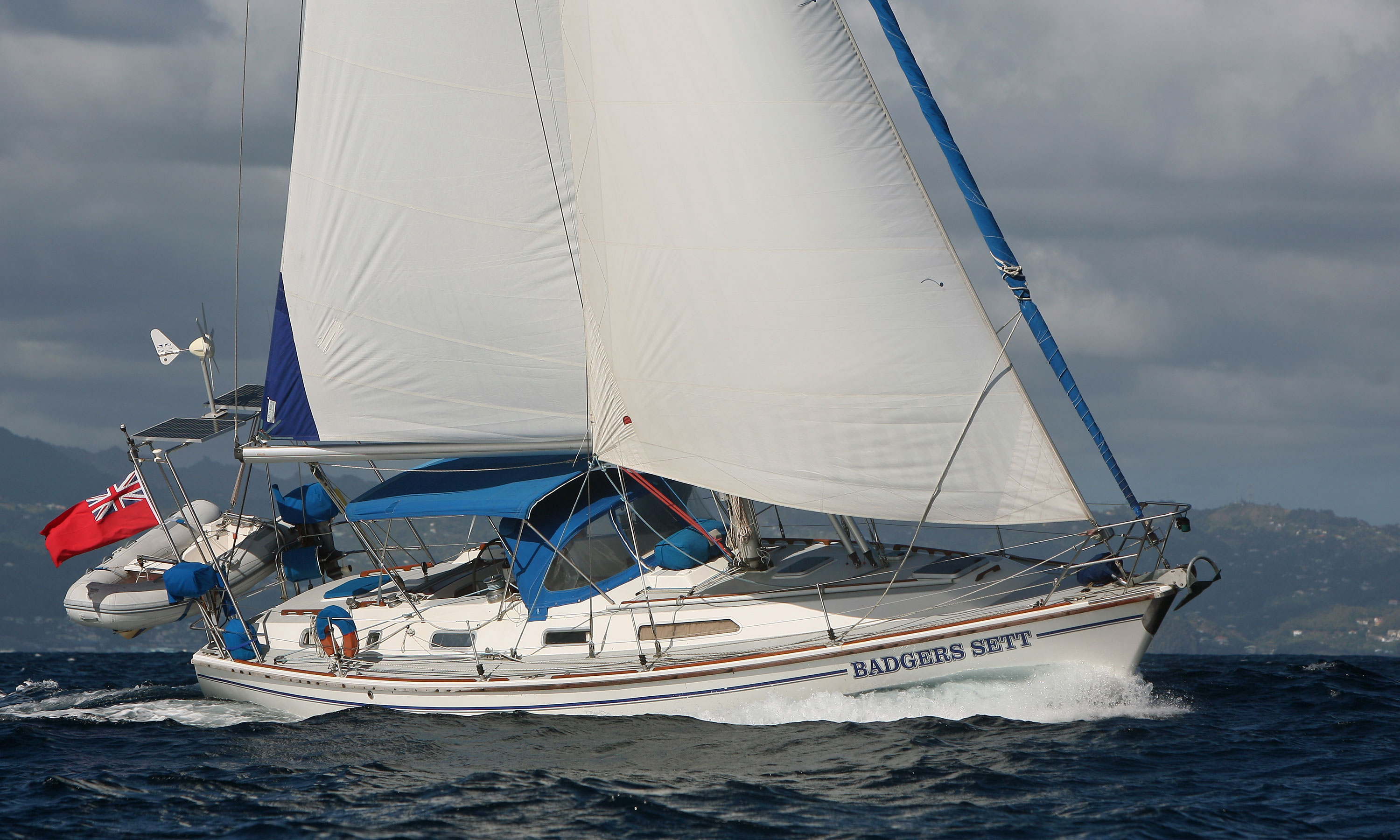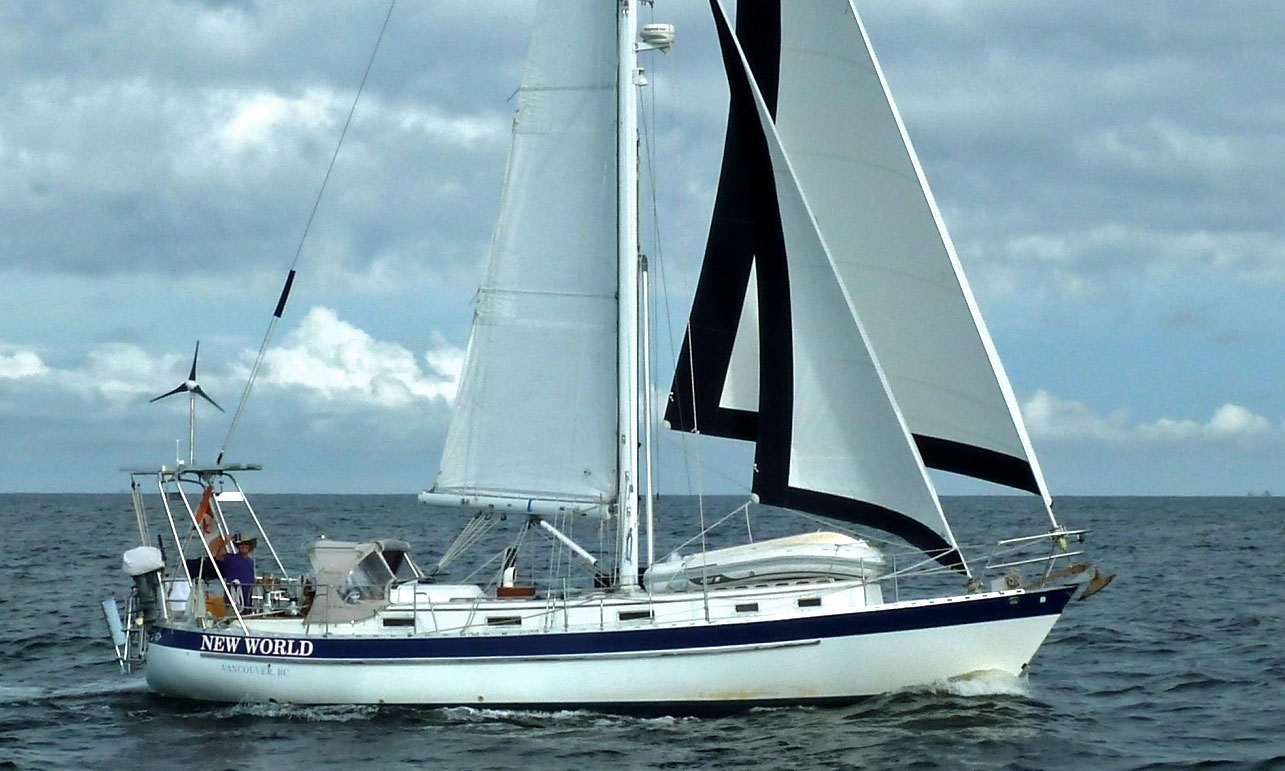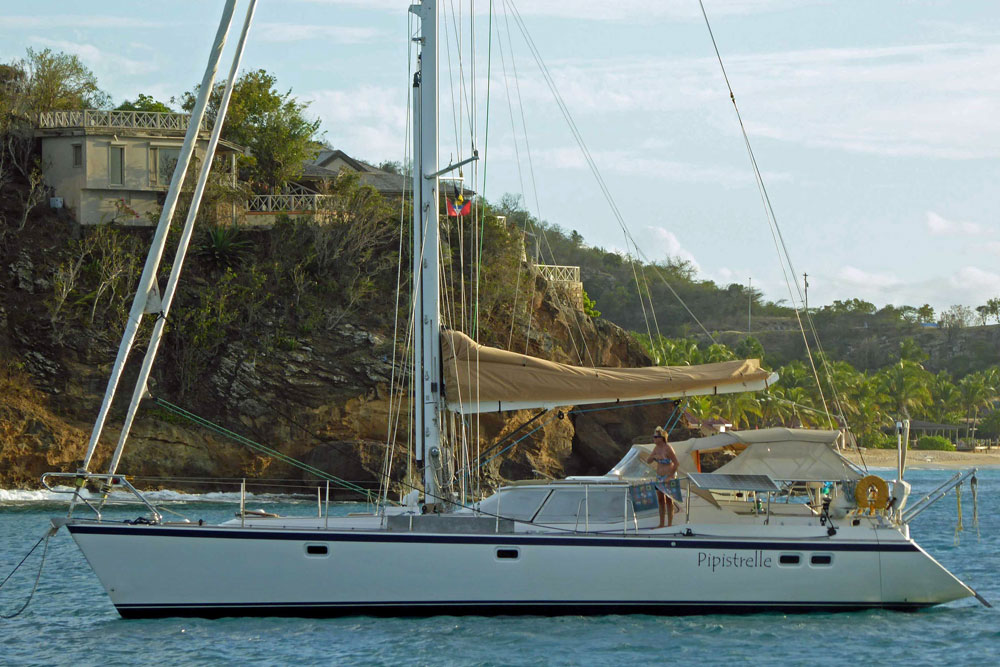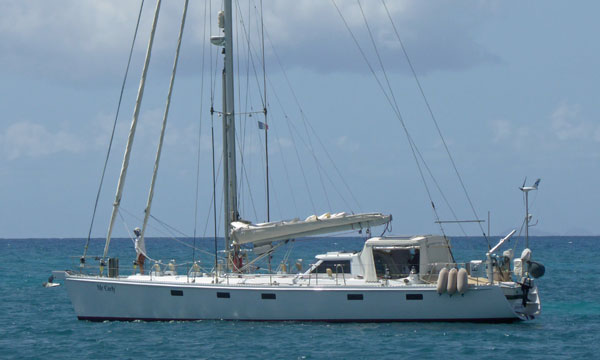- Home
- Types of Sailboats
- Cutter Rig Vs Solent Rig
Cutter Rig vs. Solent Rig: What's the Difference & Which is Better for Offshore Cruising?
In a Nutshell
This article explores the two-headsail configurations most popular for offshore sailing: the Cutter Rig and the Solent Rig.
The Cutter Rig, a traditional choice, uses two separate, purpose-built sails—a high-cut yankee and a staysail—that are often flown together to provide a balanced and powerful sail plan, particularly in heavy weather. It excels on a reach but can require running backstays (or more accurately, checkstays) to support the inner forestay.
In contrast, the Solent Rig uses two headsails on parallel stays that are flown one at a time, offering simplicity and versatility, especially for short-handed cruising. It's often easier and less expensive to retrofit and requires no additional backstays. The best choice depends on your sailing style, budget, and desired level of performance and simplicity.
 The skipper of this Solent-Rigged Westerly Oceanlord 41 has found the sweet spot with the #2 headsail set and the #1 furled away.
The skipper of this Solent-Rigged Westerly Oceanlord 41 has found the sweet spot with the #2 headsail set and the #1 furled away.Table of Contents
For years, the cutter rig has been a trusted companion for offshore sailors, offering greater flexibility and easier sail handling than a simple sloop rig in varying wind and sea conditions. However, a modern rival is gaining traction: the Solent Rig. You'll notice this trend in anchorages around the world, as more cruisers opt for its distinct advantages.
But what are the key differences between these two rigs, and why are many sailors making the switch? And why's it called the "Solent Rig" anyway?
Why "Solent Rig"?
The term "Solent Rig" is so-called because it is named after The Solent, the famously challenging strait of water between mainland Britain and the Isle of Wight.
The strong, often unpredictable winds and tidal currents found in this area led British sailors to prefer a smaller, more easily handled headsail for upwind sailing, especially when beating against the wind. The 100% jib, which is a key component of the Solent Rig, was considered ideal for these conditions. As such, the rig that features this type of sail, or the sail itself, became colloquially known as a "Solent" after the waters where it proved so effective.
In the US, the term "Solent Rig" is less common and often not used at all. On that side of the pond it's more likely to be referred to as the "slutter" rig, a jocular term derived from combining "sloop" and "cutter."
What Are the Physical Characteristics of Cutter & Solent Rigs?
The most straightforward way to differentiate a cutter from a Solent Rig is by looking at how their two headsails are set up.
- A Cutter Rig: The two headsails are set well apart, with the inner stay attached a distance down from the masthead and aft of the stemhead. This configuration allows both sails—a high-cut yankee and a smaller staysail—to be flown simultaneously, with the staysail catching the wind that escapes beneath the yankee.
- A Solent Rig: The headsails are set much closer together, with both stays attached close to the masthead and the stemhead. It is essentially a sloop with two different-sized headsails on separate, in-line stays, designed for flying one sail at a time. Usually the foremost sail is a genoa and the other, a 100% jib.
Of course, the differences go far beyond the physical layout, with each rig offering significant benefits and disadvantages.
 A cutter-rigged Valiant 40
A cutter-rigged Valiant 40 A Solent-Rigged Wauquiez 48
A Solent-Rigged Wauquiez 48How Does Each Rig Perform for Offshore Sailing?
Over the years, I've had the chance to see both rigs in action. I find that a cutter-rigged boat feels incredibly balanced and safe in a stiff breeze, with the ability to heave-to with just the staysail set—something that can be difficult with a partially furled jib. On a practical level, the smaller sails are also easier to manage on deck, spreading the sail loads across multiple points rather than concentrating them on a single one.
Here is a quick comparison of the strengths and weaknesses of each rig:
| Feature | Cutter Rig | Solent Rig |
|---|---|---|
| Heavy Weather Performance | Excellent. The yankee can be furled, leaving a robust, balanced staysail and a reefed main. | Good. Can sail with a smaller, inboard jib for more control, but heaving-to may be more challenging. |
| Windward Performance | Can be hampered by the staysail stalling the forward jib in close-hauled conditions. Can require bearing away a little to find the sweet spot. | Generally better. Hard on the wind, a single sail provides a cleaner airflow over the working sail, but a furled sail can disrupt airflow. |
| Downwind Performance | The staysail will blanket the jib, and often has to be dropped. Modern sailors augment this with a Code Zero or asymmetric spinnaker. | Excellent for dead-downwind sailing, as two sails can be flown "wing-and-wing," with one poled out to port and the other to starboard. |
| Sailing Simplicity | More complex. Both sails are intended to be flown together, which can require more lines in the cockpit and more careful trimming. | Simpler. You typically sail with one headsail or the other, reducing the number of active sheets. |
| Tacking | Easier. The jib can be tacked through the gap between it and the staysail without needing to be furled. | Harder. The forward sail must be fully furled before tacking and then hauled out again on the new tack. |
| Rigging & Upkeep | More complex. The inner forestay often requires running backstays or aft intermediate stays to support the forward mast pull. | Simpler. As both stays attach near the masthead, additional backstays are not required. |
How the Furled Sail Affects Performance
- Disrupted Airflow: A sail generates propulsive force by acting as an airfoil, creating lift and drag as air moves across its surface. The furled sail on the forward stay of a Solent Rig acts as a rigid, turbulent object directly in front of the working sail. It disrupts the laminar flow of air to the working sail, reducing the efficiency of both lift and drag.
- Reduced Drive: The furled sail creates turbulence on the windward side and a "wind shadow" on the leeward side of the working sail. This turbulence reduces the pressure difference—the key to generating drive—between the two sides of the working sail. The result is a substantial decrease in forward propulsion, which means a slower boat and a reduced ability to point high into the wind.
- Compromised Sail Shape: A partially furled sail, which is a common way to reef on a sloop rig, also has poor aerodynamic performance. The sail's carefully engineered shape, or camber, is ruined as the sail is rolled, moving the center of effort and creating a very inefficient profile that is less effective for windward work. This is why a Solent Rig is often preferred, as it allows sailors to fully furl the larger headsail and deploy a smaller, perfectly shaped jib.
The furled sail's negative impact on performance is why many sailors with a Solent Rig will fully furl the larger headsail and use the smaller, inboard sail for upwind sailing, as it offers a cleaner airflow and a better sail shape for beating.
Can You Retrofit a Cutter or Solent Rig?
Adding a second forestay to a pre-existing sloop rig is a common practice for many cruisers seeking greater versatility. The simplicity of the Solent Rig makes it a popular option for retrofits. Since the second stay attaches near the masthead, it doesn't require a complex system of running backstays to support the mast.
On the other hand, retrofitting a true cutter rig, with its inner stay attached well down the mast, is a more complex undertaking that requires significant structural reinforcement of the deck and the mast itself. This usually involves adding running backstays or a similar support system to counteract the forward pull of the inner stay. This is a critical safety consideration and should not be overlooked.
The Best of Both Worlds: A Solent-Rigged Cutter?
Some sailors have explored a hybrid of both rigs, adding a staysail to a solent-rigged boat. The goal is to combine the simplicity of the Solent Rig with the heavy-weather capabilities of a cutter. This can result in a lot of extra lines in the cockpit and on deck, but for a well-organised skipper, it offers an incredibly versatile and powerful sail plan, which is why this sail configuration is often chosen by skippers of single-handed round-the-world race boats.
 'Mr Curly', a 65' Chuck Paine design has 3 headsails to choose from
'Mr Curly', a 65' Chuck Paine design has 3 headsails to choose fromWhether you’re the prouder owner of a 65footer like the one above, or considering the purchase of a rather more modest one, understanding the different sail rigs is crucial. To explore this topic further and see how the various rigs fit into the wider world of sailboat design, be sure to check out our article “The Ultimate Guide to Sailboats & Rigs: Sloops, Ketches & More.”
This article was written by Dick McClary, RYA Yachtmaster and author of the RYA publications 'Offshore Sailing' and 'Fishing Afloat', member of The Yachting Journalists Association (YJA), and erstwhile member of the Ocean Cruising Club (OCC).
FAQs About Two-Headsail Rigs
What is a "yankee" headsail?
What is a "yankee" headsail?
A yankee is a high-cut headsail, meaning its clew is significantly higher off the deck than a traditional genoa. This design helps prevent the foot of the sail from dipping into waves and allows the staysail to capture more wind.
Do I really need running backstays with a cutter rig?
Do I really need running backstays with a cutter rig?
Yes, in most cases, running backstays are a necessary component of a true cutter rig. They are crucial for supporting the mast and counteracting the forward tension placed on it by the inner forestay, especially when the staysail is set.
Can I fly both headsails on a Solent Rig?
Can I fly both headsails on a Solent Rig?
You can, but it is generally not recommended for normal sailing. The sails are set too close together, with the forward sail blanketing the aft sail. The exception is when sailing dead-downwind, where you can pole out one sail on each side.
Which rig is better for single-handed sailing?
Which rig is better for single-handed sailing?
While a cutter rig's smaller sails can be easier to manage, the Solent Rig's simplicity—only one headsail is ever flown at a time, and no running backstays are required—often makes it the preferred choice for short-handed or single-handed sailors.
How do modern sails like a Code Zero fit into these rigs?
How do modern sails like a Code Zero fit into these rigs?
Modern cruisers often use a Code Zero or similar light-air sail on a furler. This sail can be set on the outer stay of a Solent Rig or as an extra sail on a cutter, providing a powerful boost in light wind conditions.
Resources Used
- "Bluewater Cruising: Cutter Rig versus Solent Rig - Part 1" by Upffront - https://www.upffront.com/blog/sailing-equipment-1/bluewater-cruising-cutter-rig-vs-solent-rig-part-1-309
- "Cutter or sloop rig? Which is best for offshore and ocean cruising" by Rustler Yachts - https://www.rustleryachts.com/cutter-or-sloop-rig/
- "CRUISING SAILBOAT RIGS: Sloops, Cutters, and Solent Rigs" by Wavetrain - https://wavetrain.net/2015/06/17/cruising-sailboat-rigs-sloops-cutters-and-solent-rigs/
- "Fitting a Solent/ Emergency Stay" from the YBW Forum - https://forums.ybw.com/threads/fitting-a-solent-emergency-stay.502888/
- "The DIY Solent Stay or Inner Forestay" by Practical Sailor - https://www.practical-sailor.com/blog/the-diy-solent-stay-or-inner-forestay-2
- "Bluewater Cruising: Cutter Rig versus Solent Rig - Part 2" by Sailworld Cruising - https://www.sailworldcruising.com/news/212343/Cutter-Rig-versus-Solent-Rig-part-2
Recent Articles
-
Passoa 47 Sailboat Review: Comprehensive Specs & Performance Analysis
Jan 04, 26 04:57 AM
Discover the Passoa 47, a legendary aluminium blue water cruiser by Garcia. Explore technical specifications, design ratios, and why its lifting keel is a game-changer for offshore sailors. -
Sailboat Wheel Steering Maintenance & Inspection Checklist
Dec 30, 25 02:32 PM
Keep your vessel’s helm responsive and reliable with our expert maintenance checklist. Master cable tensioning and system inspections to avoid mid-passage failures. -
Modern Boat Electronics and the Latest Marine Instruments
Dec 20, 25 05:27 PM
Should sailboat instruments be linked to the latest boat electronics as a fully integrated system, or is it best to leave them as independent units?












